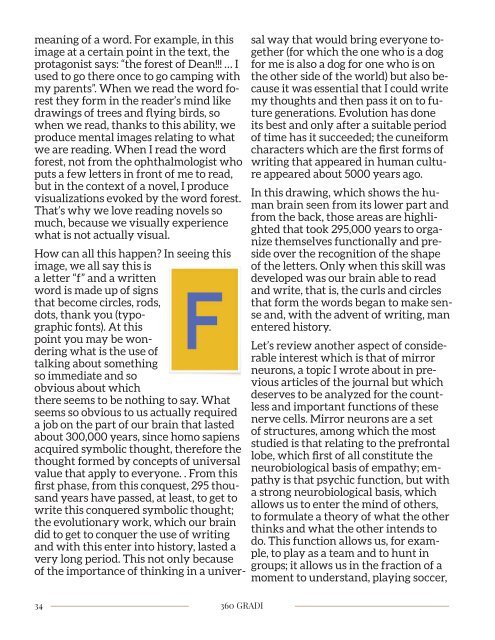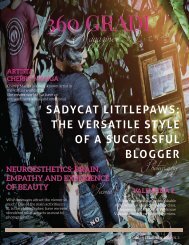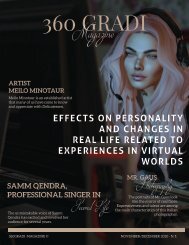360 GRADI MAGAZINE // March-April 2021
360 GRADI Magazine is the trendy, elegant, refined, and sophisticated publishing about Second Life (the virtual world by Linden Lab). Out every two months.
360 GRADI Magazine is the trendy, elegant, refined, and sophisticated publishing about Second Life (the virtual world by Linden Lab).
Out every two months.
Create successful ePaper yourself
Turn your PDF publications into a flip-book with our unique Google optimized e-Paper software.
meaning of a word. For example, in this<br />
image at a certain point in the text, the<br />
protagonist says: “the forest of Dean!!! … I<br />
used to go there once to go camping with<br />
my parents”. When we read the word forest<br />
they form in the reader’s mind like<br />
drawings of trees and flying birds, so<br />
when we read, thanks to this ability, we<br />
produce mental images relating to what<br />
we are reading. When I read the word<br />
forest, not from the ophthalmologist who<br />
puts a few letters in front of me to read,<br />
but in the context of a novel, I produce<br />
visualizations evoked by the word forest.<br />
That’s why we love reading novels so<br />
much, because we visually experience<br />
what is not actually visual.<br />
How can all this happen? In seeing this<br />
image, we all say this is<br />
a letter “f” and a written<br />
word is made up of signs<br />
that become circles, rods,<br />
dots, thank you (typographic<br />
fonts). At this<br />
point you may be wondering<br />
what is the use of<br />
talking about something<br />
so immediate and so<br />
obvious about which<br />
there seems to be nothing to say. What<br />
seems so obvious to us actually required<br />
a job on the part of our brain that lasted<br />
about 300,000 years, since homo sapiens<br />
acquired symbolic thought, therefore the<br />
thought formed by concepts of universal<br />
value that apply to everyone. . From this<br />
first phase, from this conquest, 295 thousand<br />
years have passed, at least, to get to<br />
write this conquered symbolic thought;<br />
the evolutionary work, which our brain<br />
did to get to conquer the use of writing<br />
and with this enter into history, lasted a<br />
very long period. This not only because<br />
of the importance of thinking in a universal<br />
way that would bring everyone together<br />
(for which the one who is a dog<br />
for me is also a dog for one who is on<br />
the other side of the world) but also because<br />
it was essential that I could write<br />
my thoughts and then pass it on to future<br />
generations. Evolution has done<br />
its best and only after a suitable period<br />
of time has it succeeded; the cuneiform<br />
characters which are the first forms of<br />
writing that appeared in human culture<br />
appeared about 5000 years ago.<br />
In this drawing, which shows the human<br />
brain seen from its lower part and<br />
from the back, those areas are highlighted<br />
that took 295,000 years to organize<br />
themselves functionally and preside<br />
over the recognition of the shape<br />
of the letters. Only when this skill was<br />
developed was our brain able to read<br />
and write, that is, the curls and circles<br />
that form the words began to make sense<br />
and, with the advent of writing, man<br />
entered history.<br />
Let’s review another aspect of considerable<br />
interest which is that of mirror<br />
neurons, a topic I wrote about in previous<br />
articles of the journal but which<br />
deserves to be analyzed for the countless<br />
and important functions of these<br />
nerve cells. Mirror neurons are a set<br />
of structures, among which the most<br />
studied is that relating to the prefrontal<br />
lobe, which first of all constitute the<br />
neurobiological basis of empathy; empathy<br />
is that psychic function, but with<br />
a strong neurobiological basis, which<br />
allows us to enter the mind of others,<br />
to formulate a theory of what the other<br />
thinks and what the other intends to<br />
do. This function allows us, for example,<br />
to play as a team and to hunt in<br />
groups; it allows us in the fraction of a<br />
moment to understand, playing soccer,<br />
34 <strong>360</strong> <strong>GRADI</strong>











